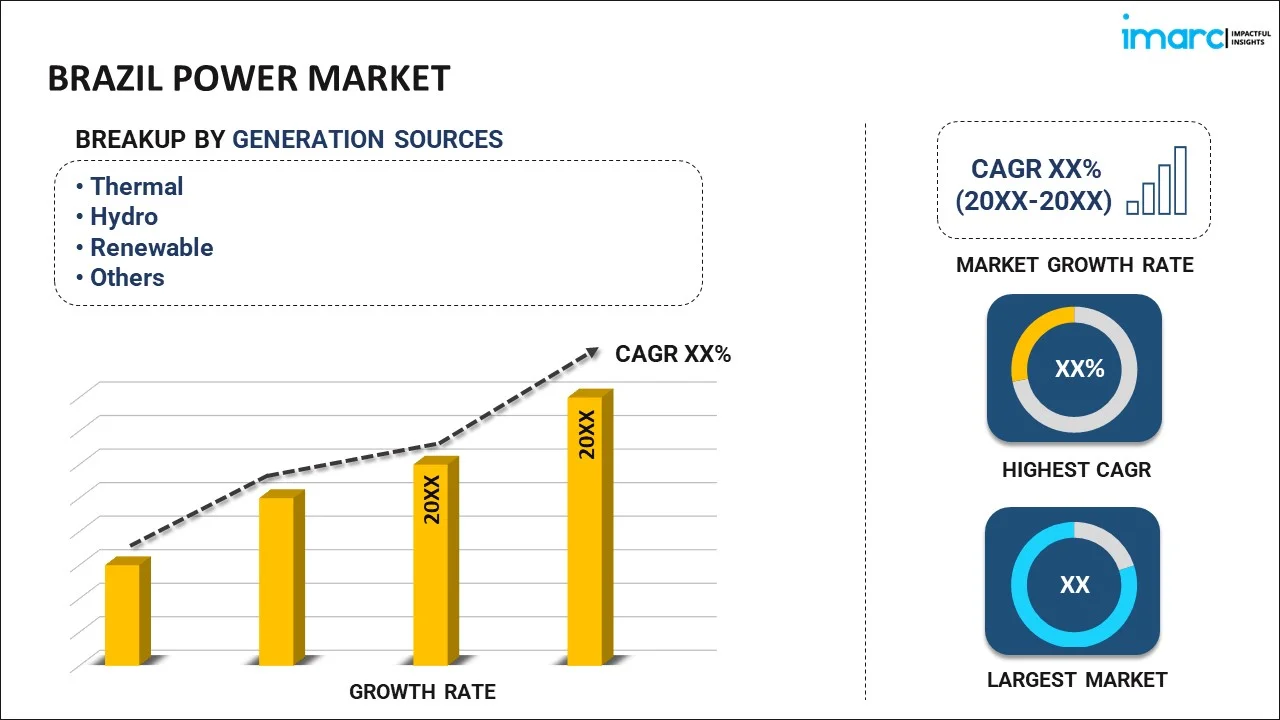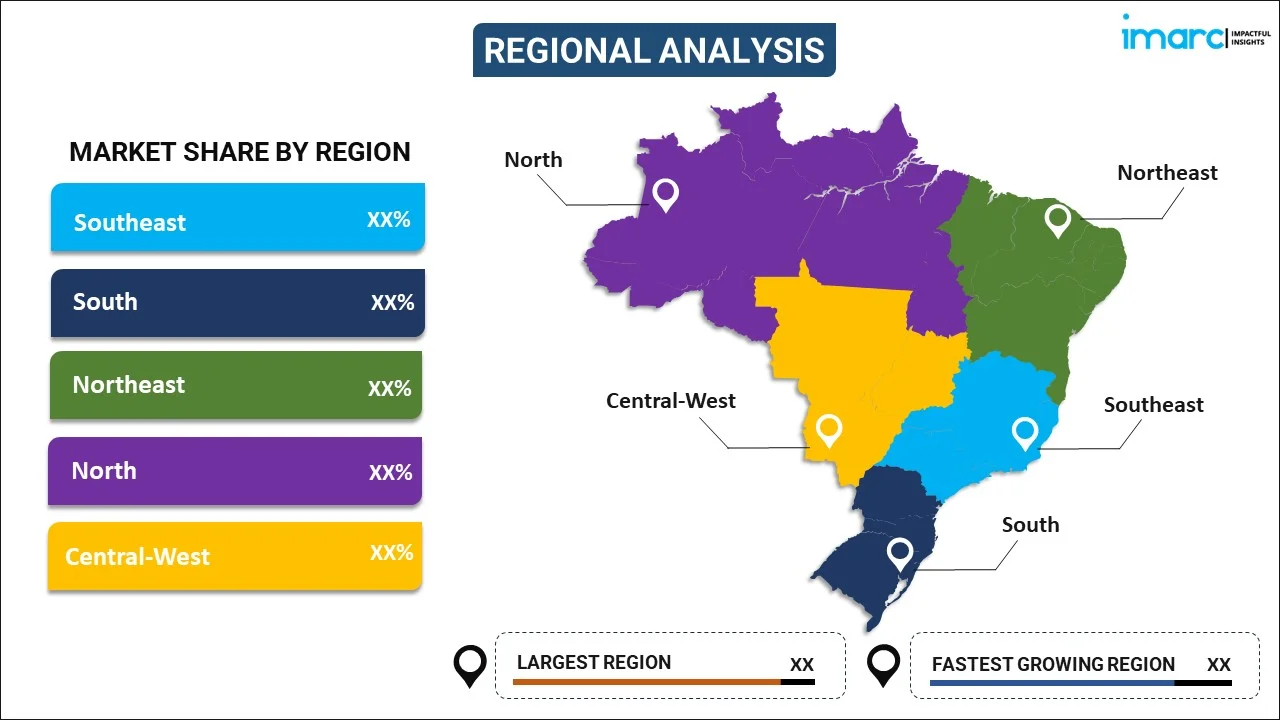
Brazil Power Market Size Report by Generation Source (Thermal, Hydro, Renewable, and Others), and Region 2026-2034
Brazil Power Market:
Brazil power market size reached 253.5 GW in 2025. Looking forward, IMARC Group expects the market to reach 473.9 GW by 2034, exhibiting a growth rate (CAGR) of 7.20% during 2026-2034. Key drivers of the market include the shift toward renewable energy, modernization efforts in grid infrastructure, and inefficiencies from aging power systems. Other important factors are diversification away from hydropower, expansion of transmission networks, growth in distributed generation, and increased corporate demand for green energy.
|
Report Attribute
|
Key Statistics
|
|---|---|
|
Base Year
|
2025
|
|
Forecast Years
|
2026-2034
|
|
Historical Years
|
2020-2025
|
|
Market Size in 2025
|
253.5 GW |
|
Market Forecast in 2034
|
473.9 GW |
| Market Growth Rate 2026-2034 | 7.20% |
Brazil Power Market Analysis:
- Major Market Drivers: One of the primary drivers of change in the Brazilian power market is the growing emphasis on renewable energy sources. Moreover, the shift towards renewables aligns with global sustainability goals and has attracted investments from both domestic and international players, further propelling the Brazil power market demand.
- Key Market Trends: The growing modernization of the grid infrastructure is escalating the market growth. Additionally, the industrial expansion, urbanization, and a rising middle-class population is also driving the expansion of the industry's demand.
- Competitive Landscape: The Brazil power market analysis report has also provided a comprehensive analysis of the competitive landscape in the market. Also, detailed profiles of all major companies have been provided.
- Geographical Trends: The large urban population and commercial activities in the Southeast region create substantial demand for electricity. High-rise buildings, shopping centers, and office spaces all contribute to significant power consumption. Moreover, industrial facilities and agricultural operations, including food processing and manufacturing, drive power demand in the South region.
- Challenges and Opportunities: The aging infrastructure and volatility in global energy prices are hampering the market's growth. However, the development of energy storage solutions, such as batteries and pumped hydro storage, can help manage intermittency in renewable energy sources and improve grid stability.
Brazil Power Market Trends:
Renewable Energy Expansion
Brazil has invested heavily in renewable energy sources, particularly hydroelectric power, wind, and solar energy. For instance, according to Statista, in 2023, investments in renewable energy technology in Brazil totaled around USD 25.5 Billion. The country’s vast natural resources and favorable climatic conditions for these technologies have driven substantial growth in the sector. These factors further positively influence the Brazilian energy market forecast.
Growing Environmental Concerns
The growing awareness of environmental issues and climate change has led to a shift towards cleaner energy sources. Brazil’s commitment to reducing greenhouse gas emissions and promoting sustainable energy practices has spurred growth in the renewable energy sector. For instance, Brazil amended its NDC in March 2022, committing to decreasing GHG emissions by 37% by 2025 and 50% by 2030, compared to 2005. Brazil's obligations include a long-term goal of attaining climate neutrality by 2050 (down from 2060 in the 2020 NDC). These factors are further contributing to the power in Brazil market share.
Expansion of Hydropower Industry
The growth of the hydropower industry is a significant driver for Brazil's power market. Brazil has a long history of investing in hydropower due to its abundant water resources and the natural geography that supports large-scale hydroelectric projects. Brazilian government policies and incentives have historically favored hydropower development. Investments in infrastructure and favorable regulatory frameworks support the growth of this sector. For instance, as of 2022, Brazil had approximately 195 MW of hydroelectric projects expected to begin commercial operations that year, including Elera Renováveis' Foz do Estrela small hydro plant. Furthermore, the government has set an ambitious goal of achieving a hydroelectric capacity of 112.5 GW by 2030. These factors are augmenting the Brazil hydropower market growth.
Shift toward Private Sector Participation
Brazil is gradually moving away from state dominance in the power sector by opening doors to private investment. The government's efforts to reduce public debt and enhance efficiency have led to a rise in privatization, particularly within generation and distribution. The landmark privatization of Eletrobras in 2022 marked a significant pivot, unlocking billions in private capital. This transition is also improving competitiveness and attracting foreign investors, especially in renewables and distributed energy. Regulatory changes are being introduced to support transparency and streamline market operations. With more projects funded by private entities and a growing appetite for returns in green infrastructure, this shift is expected to reshape Brazil’s power landscape over the next decade.
Upgrading the Grid for a Cleaner Future
Brazil is investing heavily in modernizing its electricity grid to support the integration of renewable sources and enhance reliability. Much of the country’s transmission infrastructure was designed for centralized hydroelectric power, but the rise of wind and solar installations demands a smarter, more flexible grid. Projects are underway to expand transmission lines into the Northeast and Central-West regions, where most renewables are located. Investments are also targeting digitalization, i.e., smart meters, grid automation, and real-time monitoring systems are being deployed to reduce losses and improve system resilience. These upgrades are essential not only for accommodating renewable growth but also for meeting Brazil’s climate goals and rising electricity demand.
Brazil Power Market Segmentation:
IMARC Group provides an analysis of the key trends in each segment of the market, along with forecasts at the country and regional levels for 2026-2034. Our report has categorized the market based on generation source.
Breakup by Generation Source:

To get more information on this market, Request Sample
- Thermal
- Hydro
- Renewable
- Others
The report has provided a detailed breakup and analysis of the market based on the generation source. This includes thermal, hydro, renewable, and others.
According to the Brazil power market outlook, hydropower is one of the prominent sources of electricity in Brazil. The country's geography and ample water resources make it ideal for hydroelectric dams. Hydropower accounts for a substantial portion of Brazil's electricity supply. Moreover, Brazil is investing in various renewable energy sources. It has significant potential for wind energy, especially in coastal regions. Wind farms are becoming a more substantial part of the energy mix. Solar energy is growing rapidly in Brazil, based on its sunny climate. Solar farms and distributed solar generation (rooftop panels) are expanding. These factors are further driving the market’s growth.
Breakup by Region:

- Southeast
- South
- Northeast
- North
- Central-West
The report has also provided a comprehensive analysis of all the major regional markets, which include Southeast, South, Northeast, North, and Central-West.
According to the Brazil power market statistics, the Southeast region has the highest power demand due to its dense population and high level of industrial activity. It is the economic powerhouse of the country, contributing significantly to both industrial and commercial energy consumption. Moreover, power demand in the South is relatively high but lower than in the Southeast. The demand is driven by both industrial activities and a substantial residential population. The region also experiences a temperate climate, which influences energy use, especially for heating in colder months. Furthermore, the Central-West has moderate power demand. This demand is primarily driven by agriculture, industry related to agribusiness, and a growing urban population. The climate is relatively hot, which can lead to higher electricity consumption for cooling.
Competitive Landscape:
The Brazil power market research report has also provided a comprehensive analysis of the competitive landscape in the market. Competitive analysis such as market structure, key player positioning, top winning strategies, competitive dashboard, and company evaluation quadrant has been covered in the report. Also, detailed profiles of all major companies have been provided.
Brazil Power Market News:
- June 2025: Hitachi Energy extended its service contract with Eletrobras for the Rio Madeira HVDC system in Brazil. Spanning 2,375 km, the system delivers 3.15 GW of power to 45 million people. The renewed EnCompass agreement supports ongoing modernization, with custom solutions enhancing seasonal reliability. Both companies aim to strengthen Brazil’s grid infrastructure with advanced technology and sustained operational efficiency, reinforcing long-term energy stability in the country.
- March 2025: Wärtsilä and Energetica Suape II S.A. announced plans to launch the world’s first large-scale ethanol-fueled engine trial at the Suape II power station in Recife. Ethanol, primarily sugarcane-based, would be tested as a clean power source. The project, initiated by Grupo Econômico 4M, highlights ethanol’s potential for reliable, low-emission electricity. Brazil leads global ethanol production, positioning this trial as a key step in scaling bioenergy for dispatchable power.
- August 2025: Prumo Logística and Fuella collaborated to create a low-carbon hydrogen center at the Port of Açu in Brazil, with a target production of 400,000 tons annually.
- April 2025: Hydro Rein and Atlas Renewable Energy launched 438-MW Boa Sorte solar power complex in Minas Gerais, Brazil.
- March 2025: The Mendubim solar facility, with a capacity of 531 MW, begun operations in Brazil, representing a major 30% increase in Equinor's equity power output in the nation.
Brazil Power Market Report Scope:
| Report Features | Details |
|---|---|
| Base Year of the Analysis | 2025 |
| Historical Period | 2020-2025 |
| Forecast Period | 2026-2034 |
| Units | GW |
| Scope of the Report | Exploration of Historical Trends and Market Outlook, Industry Catalysts and Challenges, Segment-Wise Historical and Predictive Market Assessment:
|
| Generation Sources Covered | Thermal, Hydro, Renewable, Others |
| Regions Covered | Southeast, South, Northeast, North, Central-West |
| Customization Scope | 10% Free Customization |
| Post-Sale Analyst Support | 10-12 Weeks |
| Delivery Format | PDF and Excel through Email (We can also provide the editable version of the report in PPT/Word format on special request) |
Key Benefits for Stakeholders:
- IMARC’s industry report offers a comprehensive quantitative analysis of various market segments, historical and current market trends, market forecasts, and dynamics of the Brazil power market from 2020-2034.
- The research report provides the latest information on the market drivers, challenges, and opportunities in the Brazil power market.
- Porter's five forces analysis assists stakeholders in assessing the impact of new entrants, competitive rivalry, supplier power, buyer power, and the threat of substitution. It helps stakeholders to analyze the level of competition within the Brazil power industry and its attractiveness.
- The competitive landscape allows stakeholders to understand their competitive environment and provides insight into the current positions of key players in the market.
Key Questions Answered in This Report
The power market in Brazil reached 253.5 GW in 2025.
The Brazil power market is projected to exhibit a CAGR of 7.20% during 2026-2034, reaching 473.9 GW by 2034.
Hydropower availability, economic growth, rising electricity demand, regulatory reforms, and renewable energy incentives drive Brazil power market. The country’s focus on diversifying energy sources, expanding transmission infrastructure, and attracting private investment also plays a major role. Seasonal rainfall patterns and climate variability significantly affect generation capacity.
Need more help?
- Speak to our experienced analysts for insights on the current market scenarios.
- Include additional segments and countries to customize the report as per your requirement.
- Gain an unparalleled competitive advantage in your domain by understanding how to utilize the report and positively impacting your operations and revenue.
- For further assistance, please connect with our analysts.
 Request Customization
Request Customization
 Speak to an Analyst
Speak to an Analyst
 Request Brochure
Request Brochure
 Inquire Before Buying
Inquire Before Buying




.webp)




.webp)












